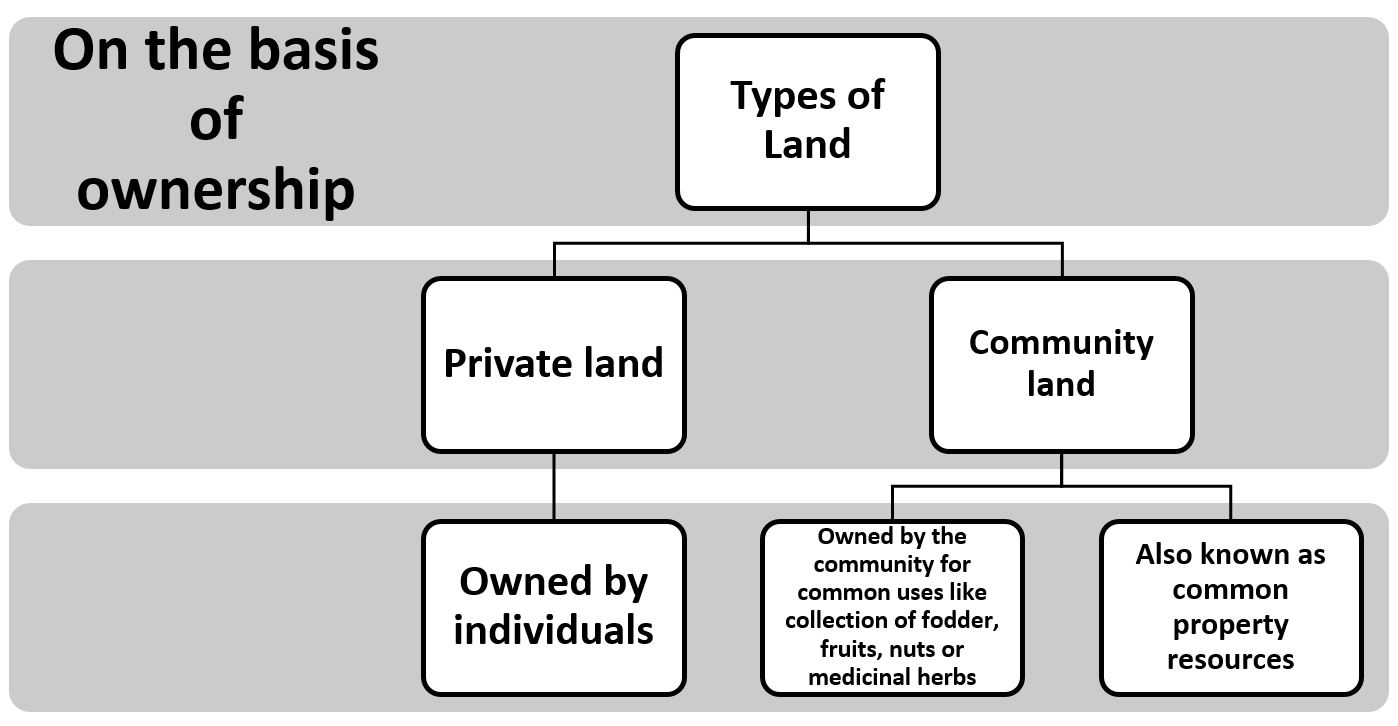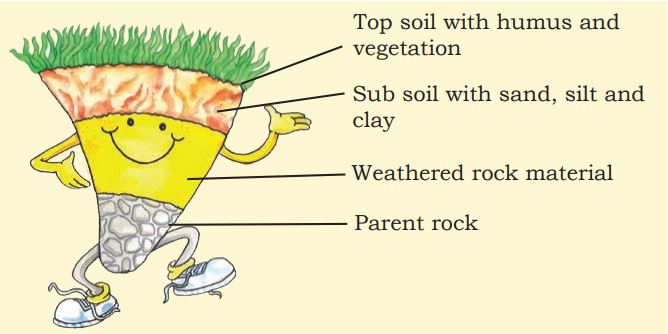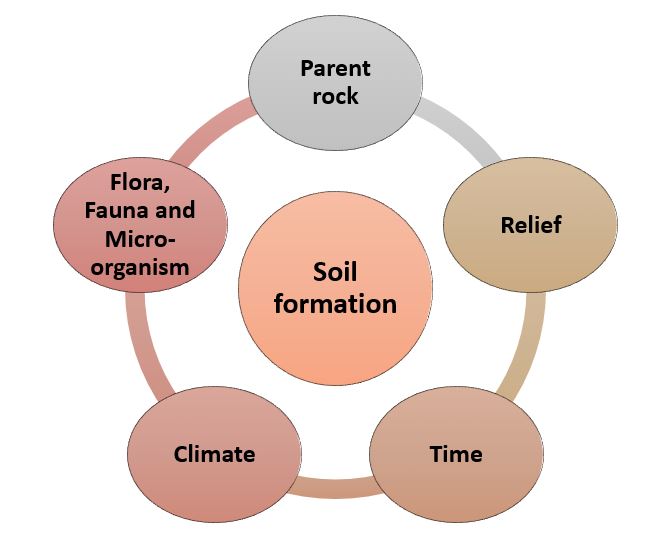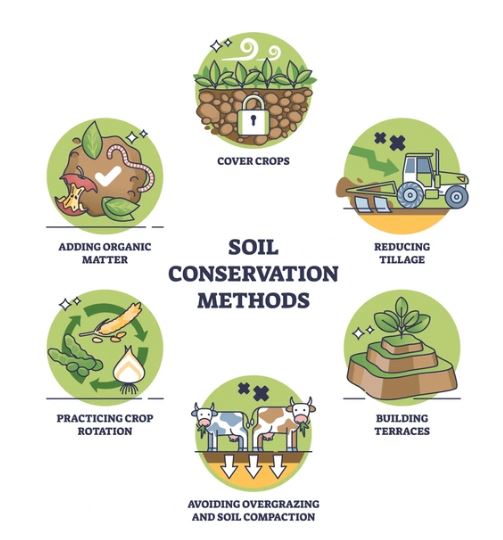Land, Soil, Water, Natural vegetation and Wildlife resources Class 8 Notes NCERT and MCQs
 22-03-2024
22-03-2024
 13:05 PM IST
13:05 PM IST
 Priyanka Chaudhary
Priyanka Chaudhary
This chapter discusses the natural resources like land, soil, water, vegetation and wildlife, their degradation as well as conservation measures.
There is difference in the quality of land, soil, water, natural vegetation, animals and usage of technology. This is the main reason why places differ from each other.
Land
- Land is among the most important natural resources. It covers only about 30% of the total area of the earth’s surface.
- 90% of the world population occupies only 30% of land area. The remaining 70% of the land is either sparsely populated or uninhabited.
- The uneven distribution of population in different parts of the world is mainly due to varied characteristics of land and climate.
Land use
- Land is used for different purposes such as agriculture, forestry, mining, building houses, roads and setting up of industries. This is commonly termed as Land use.
- The use of land is determined by physical factors such as topography, soil, climate, minerals and availability of water and human factors like population and technology.
- People and their demands are ever growing but the availability of land is limited.
- Land degradation, landslides, soil erosion, desertification are the major threats to the environment because of the expansion of agriculture and construction activities.
Conservation of land
- Growing population and increasing demand has led to a large-scale destruction of forest cover and arable land and has created a fear of losing this natural resource.
- Common methods used to conserve land resources:
- Afforestation
- Land reclamation
- Regulated use of chemical pesticide and fertilisers
- Checks on overgrazing
Landslide
- Landslides are defined as the mass movement of rock, debris or earth down a slope.
- They often take place in conjunction with earthquakes, floods and volcanoes.
- A prolonged spell of rainfall can cause heavy landslides that can block the flow of river for quite some time. The formation of river blocks can cause havoc to the settlements downstream on its bursting.
- In the hilly terrain, landslides have been a major and widely spread natural disaster that often strike life and property and occupy a position of major concern.
- Some broad mitigation techniques for landslide are as follows:
- Hazard mapping to locate areas prone to landslides. Hence, such areas can be avoided for building settlements.
- Construction of retention wall to stop land from slipping.
- Increase in the vegetation cover to arrest landslide.
- The surface drainage control works to control the movement of landslide along with rain water and spring flows.
Soil
The thin layer of grainy substance covering the surface of the earth is called soil.
Fig: Soil Profile
Soil is made up of organic matter, minerals and weathered rocks found on the earth. This happens through the process of weathering.
Weathering: The breaking up and decay of exposed rocks, by temperature changes, frost action, plants, animals and human activity.
Factors of Soil Formation
- Parent Rock: Determines colour, texture, chemical properties mineral, content, permeability.
- Climate: Temperature, Rainfall influence rate of weathering and humus formation.
- Relief: Altitude and slope, determine accumulation of soil.
- Flora, Fauna and Micro-organism: Affect the rate of humus formation.
- Time: Determines thickness of soil profile.
Types of Soil in India: Alluvial, Red, Black, Laterite, Desert and Mountain soil.
Soil degradation
Soil erosion and depletion are the major threats to soil as a resource.
Factors which lead to soil degradation are:
- Deforestation
- Overgrazing
- Overuse of chemical feritilisers or pesticides
- Rain wash
- Landslides
- Floods
Soil conservation
- Mulching: The bare ground between plants is covered with a layer of organic matter like straw. It helps to retain soil moisture.
- Contour barriers: Stones, grass and soil is used to build barriers along contours. Trenches are made in front of the barriers to collect water.
- Rock dam: Rocks are piled up to slow down the flow of water. This prevents gullies and further soil loss.
- Terrace farming: Broad flat steps or terraces are made on the steep slopes so that flat surfaces are available to grow crops. They reduce surface run off and soil erosion.
- Intercropping: Different crops are grown in alternate rows and are sown at different times to protect the soil from rain wash.
- Contour ploughing: Ploughing parallel to the contours of a hill slope to form a natural barrier for water to flow down the slope.
- Shelter belts: In the coastal and dry regions, rows of trees are planted to check the wind movement to protect soil cover.
Water
- Water is a vital renewable natural resource. Three-fourth of the earth’s surface is covered with water.
- Fresh water accounts for only about 2.7%. Only 1% of freshwater is available and fit for human use. It is found as groundwater, as surface water in rivers and lakes and as water vapour in the atmosphere.
- Nearly 70% of fresh water is in the form of ice sheets and glaciers in Antarctica, Greenland and mountain regions and is inaccessible.
- Water can neither be added nor subtracted from the earth. Its total volume remains constant. Its abundance only seems to vary because it is in constant motion, cycling through the oceans, the air, the land and back again, through the processes of evaporation, precipitation and run-off. This is referred to as the ‘water cycle’.
Problems of water availability
- Humans use huge amounts of water not only for drinking and washing but also for agriculture, industries and generation of electricity.
- Increasing population, rising demands for food and cash crops, increasing urbanisation and rising standards of living are the major factors leading to shortages in supply of fresh water either due to drying up of water sources or water pollution.
- Most of Africa, West Asia, South Asia, parts of western USA, north-west Mexico, parts of South America and entire Australia are facing shortages in fresh water supply.
- Water shortage may be a consequence of variation in seasonal or annual precipitation or the scarcity is caused by over-exploitation and contamination of water sources.
- Discharge of untreated or partially treated sewage, agricultural chemicals and industrial effluents in water bodies are major contaminants. They pollute water with nitrates, metals and pesticides.
Water Conservation
- Water pollution can be controlled by treating these effluents suitably before releasing them into water bodies.
- Forest and other vegetation cover slow the surface runoff and replenish underground water.
- Water harvesting is another method to save surface runoff. Rain water harvesting is the process of collecting rain water from roof tops and directing it to an appropriate location where it is stored for future use.
- The canals used for irrigating field should be properly lined to minimise losses by water seepage.
- Sprinklers effectively irrigate the area by checking water losses through seepage and evaporation.
- In dry regions with high rates of evaporation, drip or trickle irrigation is very useful.
Natural Vegetation and Wildlife
- Natural vegetation and wildlife exist only in the narrow zone of contact between the lithosphere, hydrosphere and atmosphere which is called biosphere.
- In the biosphere living beings are inter-related and interdependent on each other for survival. This life supporting system is known as the ecosystem.
- Plants provide us with timber, give shelter to animals, produce oxygen we breathe, protect soils so essential for growing crops, act as shelter belts, help in storage of underground water, give us fruits, nuts, latex, turpentine oil, gum, medicinal plants and also the paper.
- Wildlife includes animals, birds, insects as well as aquatic life forms. They provide us milk, meat, hides and wool. Insects like bees provide us honey, help in pollination of flowers and have an important role to play as decomposers in the ecosystem.
- Vulture due to its ability to feed on dead livestock is a scavenger and considered a vital cleanser of the environment.
Distribution of Natural Vegetation
- In areas of heavy rainfall, huge trees may thrive. The forests are thus associated with areas having abundant water supply.
- As the amount of moisture decreases the size of trees and their density reduces.
- Short stunted trees and grasses grow in the regions of moderate rainfall forming the grasslands of the world.
- Thorny shrubs and scrubs grow in dry areas of low rainfall. In such areas, plants have deep roots and leave with thorny and waxy surfaces that reduce loss of moisture through transpiration.
- Tundra vegetation of cold Polar Regions comprises of mosses and lichens.
Degradation of natural vegetation and wildlife
- To feed the growing numbers, large areas of forests have been cleared to grow crops. Forest cover all over the world is vanishing rapidly.
- Changes of climate and human interferences can cause the loss of natural habitats for plants and animals.
- Many species have become vulnerable or endangered and some are on the verge of extinction.
- Vultures in the Indian subcontinent were dying of kidney failure shortly after scavenging livestock treated with diclofenac, a painkiller that is similar to aspirin or ibuprofen.
- Deforestation, soil erosion, constructional activities, forest fires, tsunami and landslides are some of the human and natural factors which accelerate the process of extinction of many species.
- The animals are poached for collection and illegal trade of hides, skins, nails, teeth, horns as well as feathers. Some of these animals are tiger, lion, elephant, deer, black buck, crocodile, rhinoceros, snow leopard, ostrich and peacock.
Conservation of Natural Vegetation and Wildlife
- National parks, wildlife sanctuaries, biosphere reserves are made to protect our natural vegetation and wildlife. Conservation of creeks, lakes, and wetlands is necessary to save the precious resource from depletion.
- National Park is a natural area designated to protect the ecological integrity of one or more ecosystems for the present and the future generations.
- Biosphere reserves are a series of protected areas linked through a global network, intended to demonstrate the relationship between conservation and development.
- Awareness programmes like social forestry and Vanamohatasava should be encouraged at the regional and community level.
- School children should be encouraged to bird watch and visit nature camps so that they appreciate the habitat of varied species.
- Many countries have passed laws against the trade as well as killing of birds and animals. In India, killing lions, tigers, deers, great Indian bustards and peacocks is illegal.
CITES
- An international convention CITES has been established that lists several species of animals and birds in which trade is prohibited.
- CITES (the Convention on International Trade in Endangered Species of Wild Fauna and Flora) is an international agreement between governments.
- It aims to ensure that international trade in specimens of wild animals and plants does not threaten their survival.
- Roughly 5,000 species of animals and 28,000 species of plants are protected including bears, dolphins, cacti, corals, orchids and aloes.
Forest Fire
Forest fire is a threat to the entire region of fauna and flora. It occurs mainly due to three reasons:
1. Natural fire due to lightening etc.
2. Fire due to heat generated in the litter due to the carelessness of people.
3. Fire purposely caused by local inhabitants, mischief makers, miscreants etc.
Some Control Measures
1. Prevention of fires through education.
2. Prompt detection of fires through well co-ordinated network of observation points, efficient ground patroling and communication network.
MCQs based on NCERT Class 8 Geography Chapter 2: Land, Soil, Water, Natural Vegetation and Wildlife Resources
1. Which of the following is a major threat to the environment?
(a) Soil erosion
(b) Deforestation
(c) Landslide
(d) All of the above
Ans. d
2. Which one of the following is NOT a factor of soil formation?
(a) time
(b) soil texture
(c) organic matter
(d) climate
Ans. b
3. Which one of the following methods is most appropriate to check soil erosion on steep slopes?
(a) shelter belts
(b) mulching
(c) terrace cultivation
(d) crop rotation
Ans. c
4. Which one of the following is NOT in favour of the conservation of nature?
(a) switch off the bulb when not in use
(b) close the tap immediately after using
(c) dispose polypacks after shopping
(d) planting trees in neighbourhood
Ans. c
5. Which of the following is the cause of forest fire?
(a) Natural fire due to lightening
(b) Fire due to heat generated in the litter due to carelessness of people.
(c) Fire purposely caused by local inhabitants.
(d) All of the above
Ans. d
Frequently Asked Questions (FAQs) about Land, Soil, Water, Natural vegetation and Wildlife resources
Why plains and river valleys are densely populated areas of the world?
Which are the two main climatic factors responsible for soil formation?
Write any two reasons for land degradation today.
Why is land considered an important resource?
What is a biosphere?
Share Blog




 Latest
Latest 
Comments